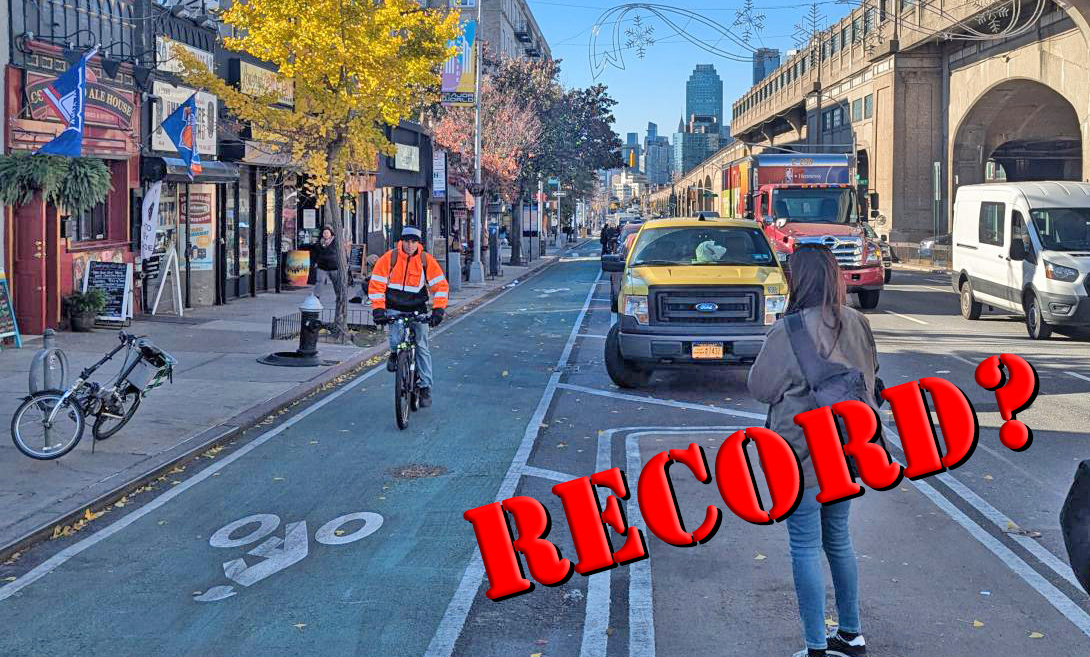From Transportation Alternatives' Spring 2008 magazine:

The biggest hurdle congestion pricing faced was the simple fact that the people required to enact the legislation were the ones who stood to pay the most because of it.
On Monday, April 7, Sheldon Silver walked out of a closed door meeting of State Assembly Democrats and announced congestion pricing was dead. Never mind that New York City's mayor and City Council supported the plan along with the governor, the State Senate and an unprecedented coalition of business, labor, environmental and civic groups. Like so much else in Albany, the decision was made in secret, without a debate, a vote or even a record of the proceedings.
Until congestion pricing came around, I never paid all that much attention to Albany. Sure, I knew about the sex and graft scandals, the "three men in a room," and the Brennan Center reports showing New York's government has more in common with the old Soviet Politburo than America's 49 other state legislatures. I knew "dysfunctional" was the official adjective to describe Albany. But the dysfunction never seemed to impinge on my own life in any immediate, tangible way. Until congestion pricing.
I was really looking forward to seeing motorists pay to drive into Lower Manhattan. While I understood the importance of $354 million in federal aid, $491 million per year in revenue for transit and fewer kids growing up with asthma, this wasn't what pumped me up. What I liked most about congestion pricing was the fact that the people who make life in New York City most miserable -- the armada of horn-honking, exhaust-spewing, space-hogging, oil-guzzling, climate change-inducing motorheads that rolls through my neighborhood every day, to and from the free East River bridges, were finally going to have to pay for the privilege.
Assembly Democrats gave lots of reasons why they couldn't support pricing, few of which dealt with substance and most of which boiled down to their feeling that an arrogant, imperious billionaire mayor and his elitist supporters were trying to stick it to New York City's poor and middle class. No matter that New York City's poor and middle class already pay a fare to ride the subway and bus and that the number one propagator of this populist claptrap was Richard Brodsky, a Westchester Assemblyman who represents the region's wealthiest Manhattan-bound car commuters, average annual income, $176,231. At least Brodsky did a good job standing up for his constituents. That's a hell of a lot more than Joan Millman, Deborah Glick, Hakeem Jeffries, Daniel O'Donnel, Jonathan Bing and the rest of the city's Assembly delegation can say for itself.
The moment I realized pricing was doomed in the legislature was when Denny Farrell, a 34-year Assembly veteran, stood up before the Congestion Mitigation Commission, of which he was a member, and delivered an impassioned speech against toll booths on the bridges between Manhattan and the Bronx. Toll booths, Farrell said, would "freeze all of northern Manhattan in gridlock" on Yankees game nights. The speech took place not at the first Commission hearing in September but at the penultimate meeting in January. Somehow, incredibly, Farrell managed to sit through four months of meetings and hearings without realizing that congestion pricing fees are collected electronically; toll booths were not part of the plan. This was the guy who was assigned to bring the work of the Commission back to his colleagues in the Assembly and he either wasn't paying attention or simply didn't care.
During Commission meetings, Farrell frequently shared his experiences driving and parking in the city. Invariably, his personal transportation anecdotes never involved a subway, bus, bike or even a sidewalk. It was a reminder that while New York state legislators are paid a middle class salary (by New York City standards, at least), they are still members of New York City's other elite -- the free riding class. Their unlimited parking privilege allows them to drive wherever and whenever they want. From their windshield perspective, the city is a transportation problem to be solved for cars. Ultimately, the biggest hurdle congestion pricing faced was the simple fact that the people required to enact the legislation were the ones who stood to pay the most because of it. You know that beleaguered middle class driver the Assembly kept talking about? He was a state legislator.
If any good has come of the Assembly's failure to act on congestion pricing, it's simply this: A new generation of citizen activists got to see up close and personal how broken New York State government is and how badly it's in need of fixing. Assembly members come up for election every two years and are often ushered in to office by as few as 5,000 votes. September 2008 ought to be the last time any of these legislators have the pleasure of going un-challenged in a Democratic primary.
By Aaron Naparstek. The views expressed in this article do not necessarily reflect the views of Transportation Alternatives.





